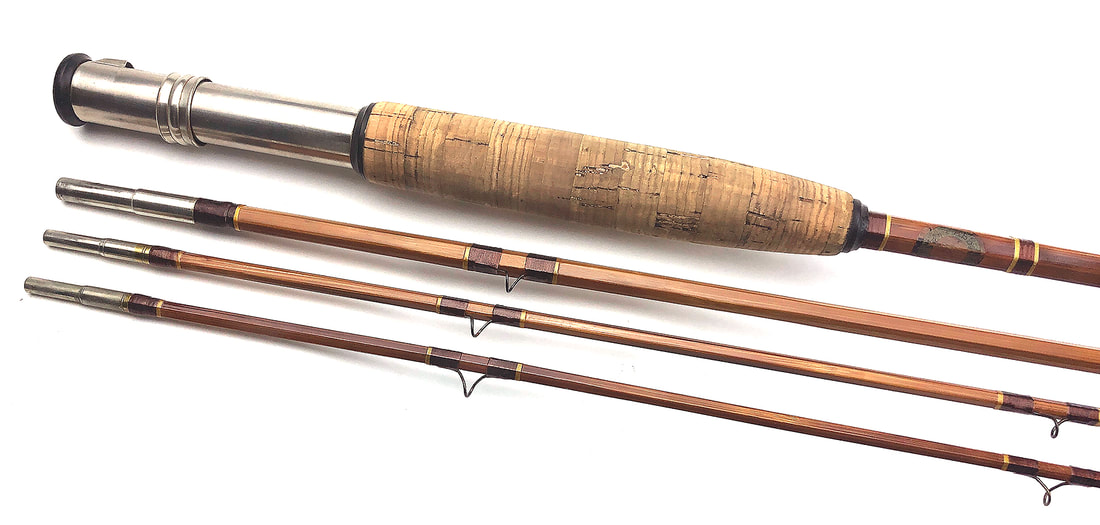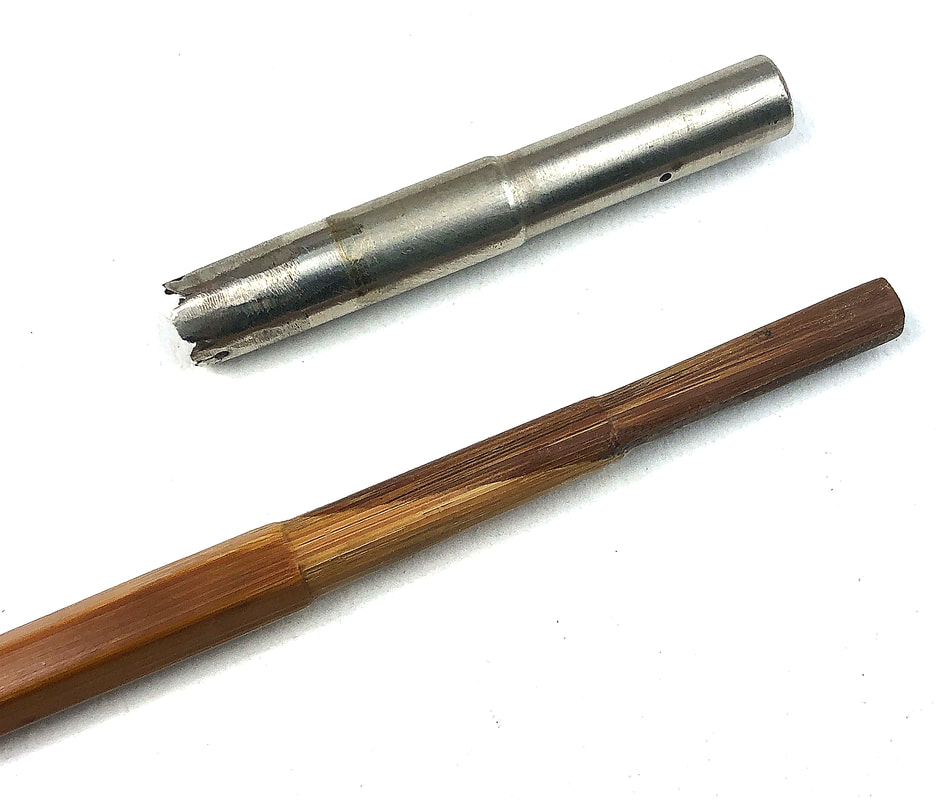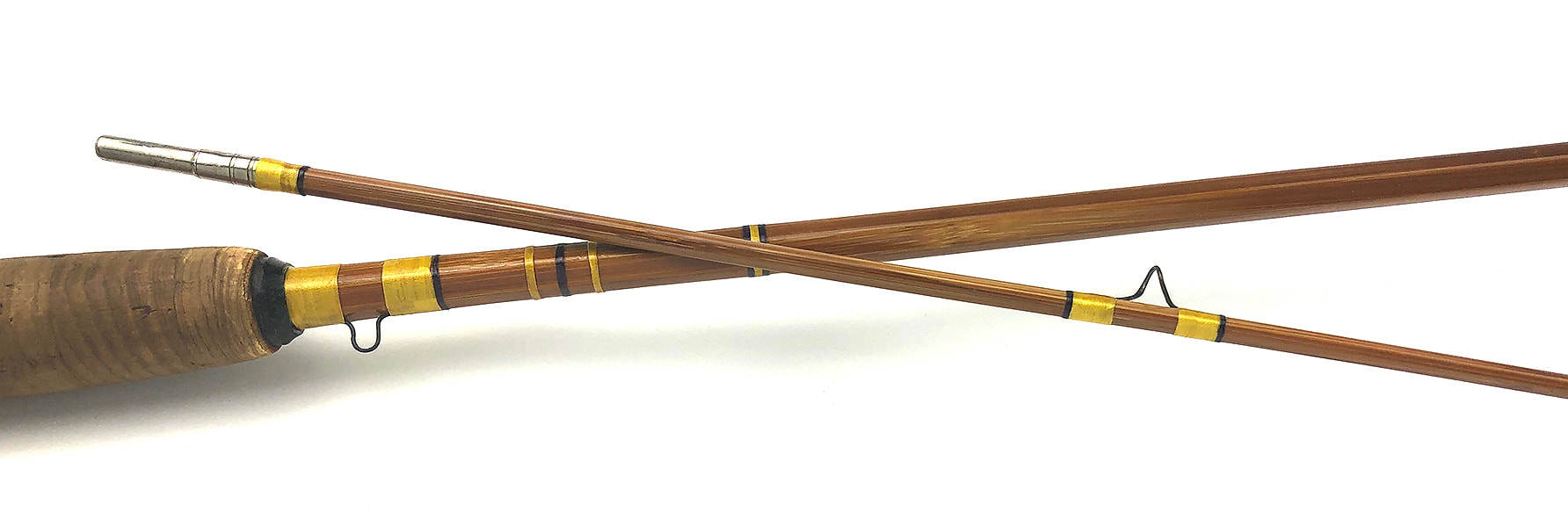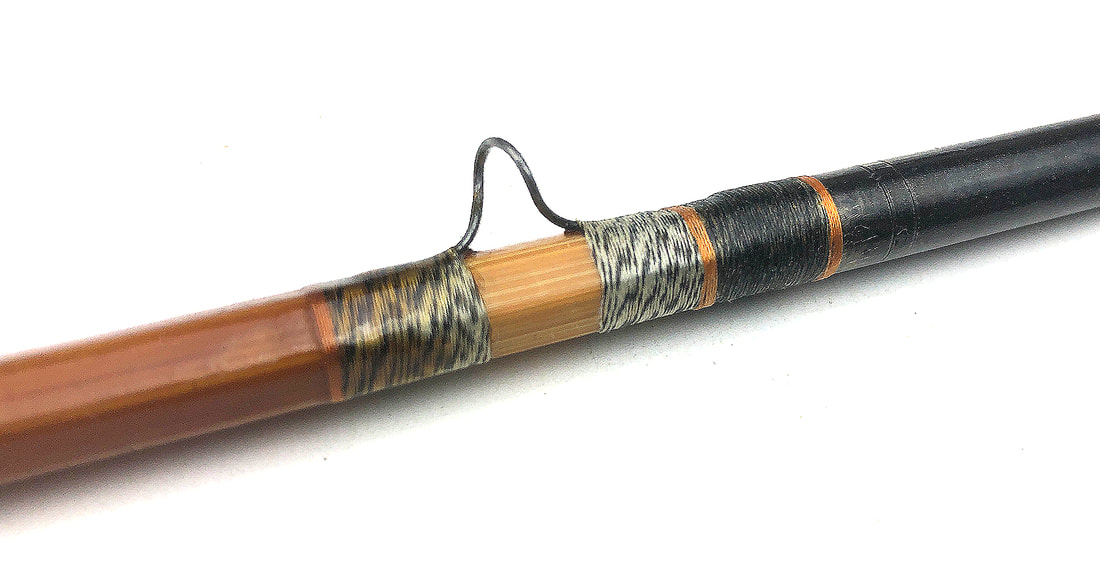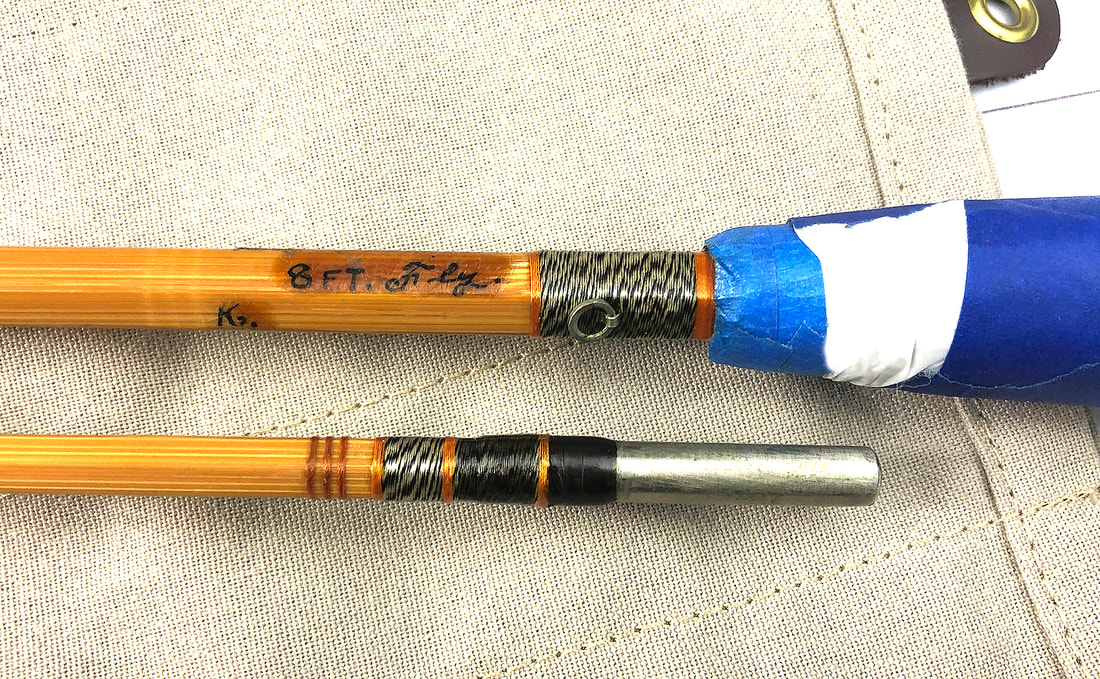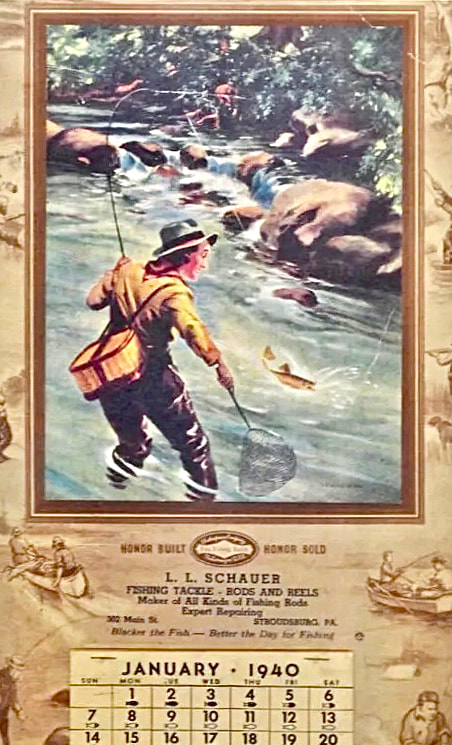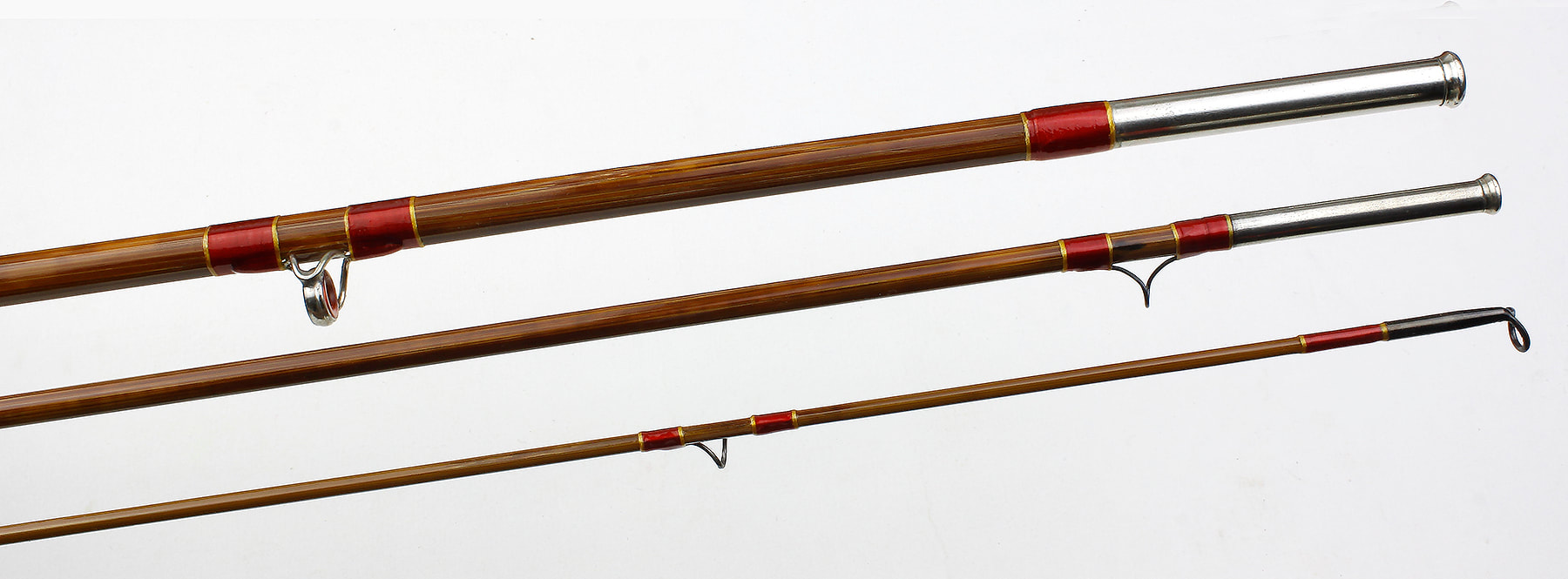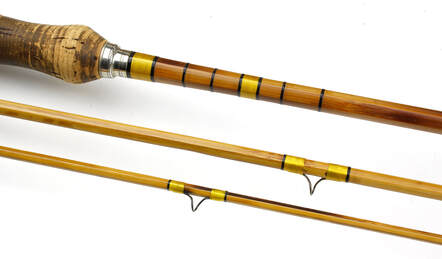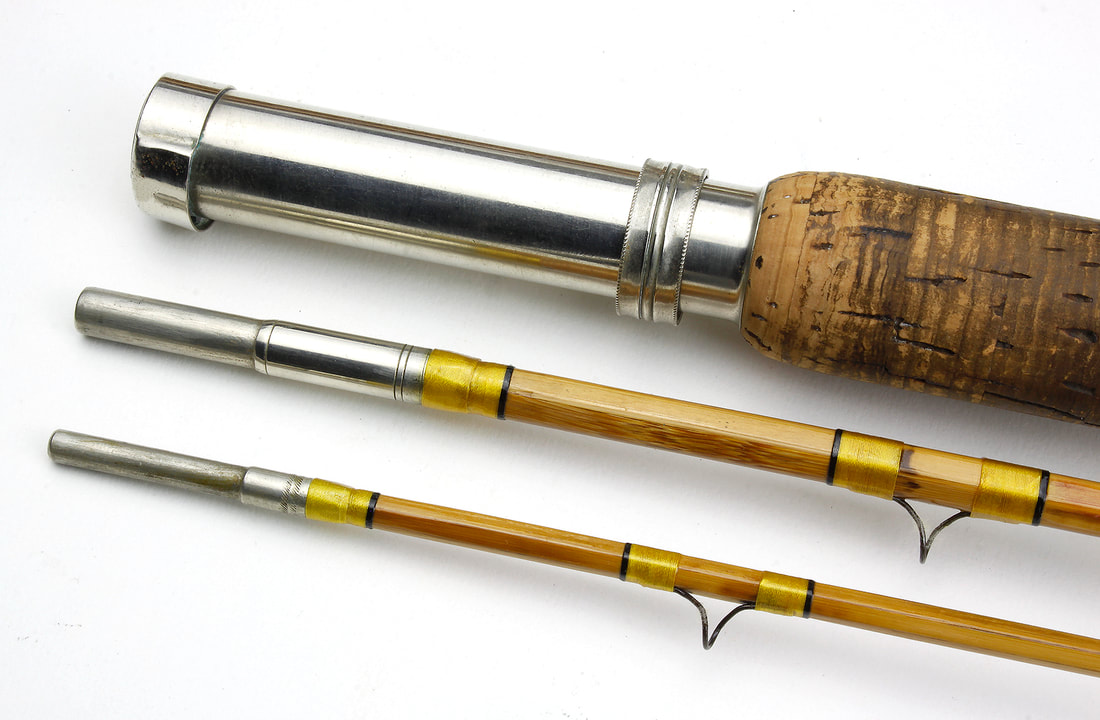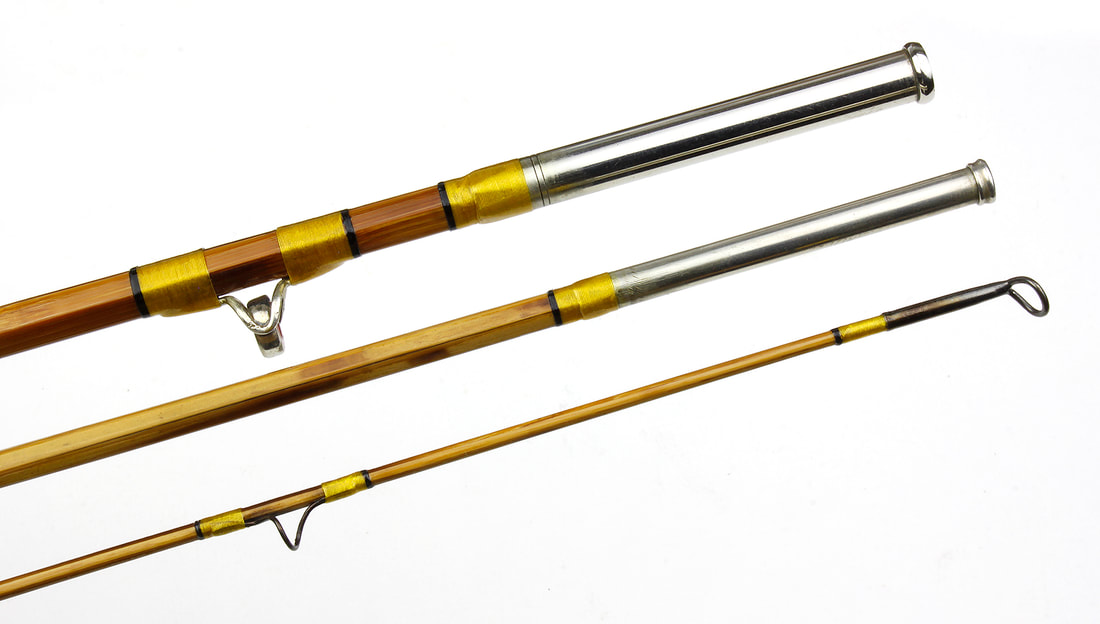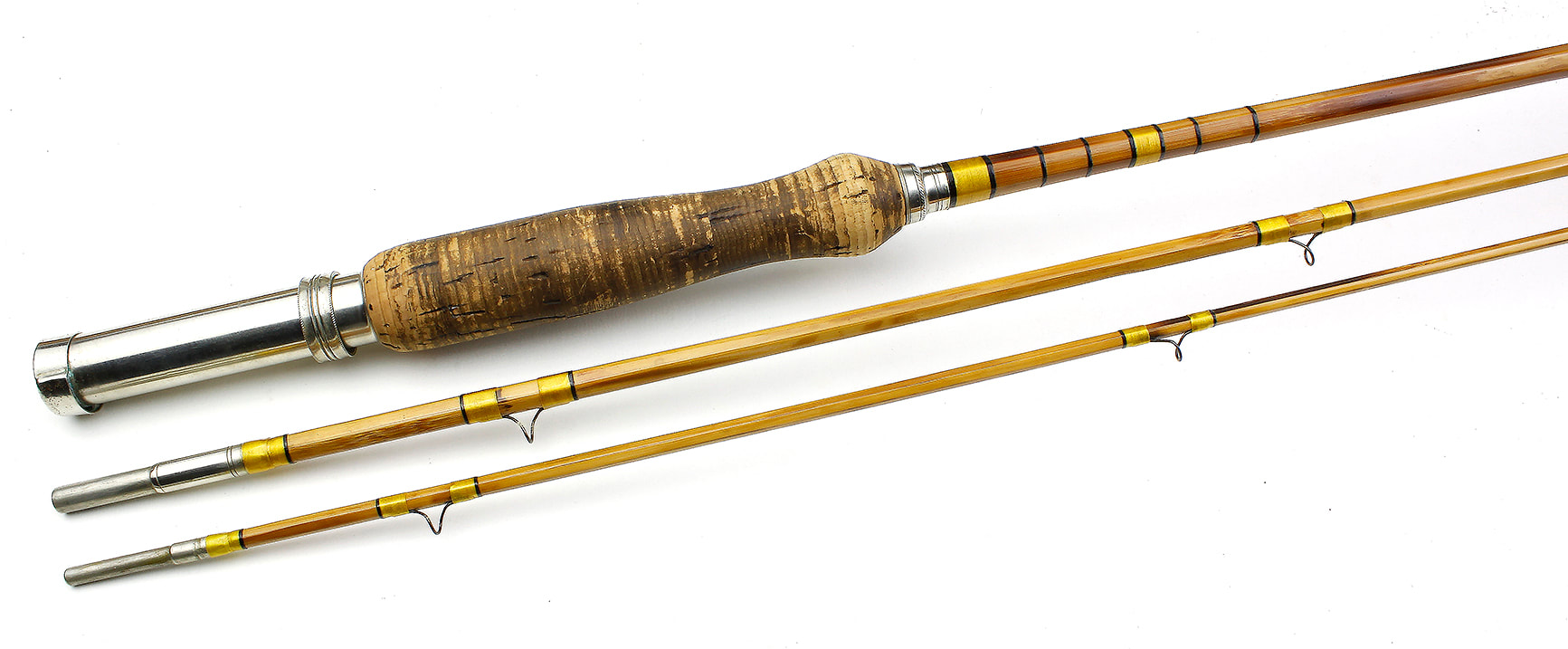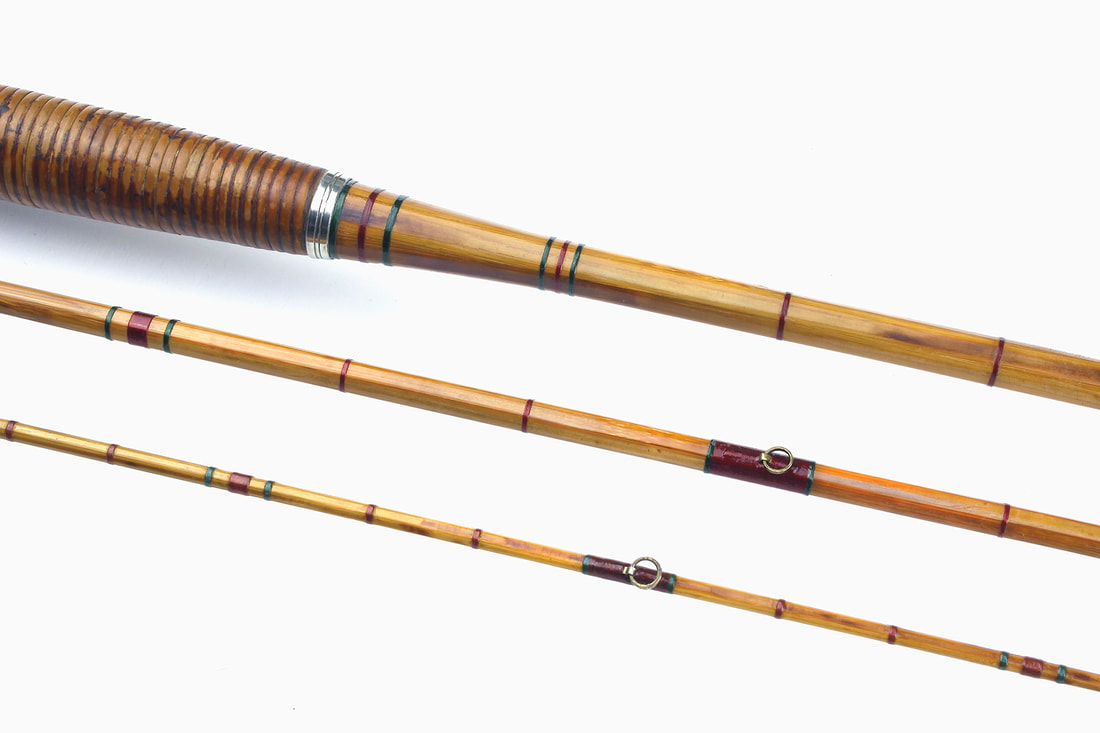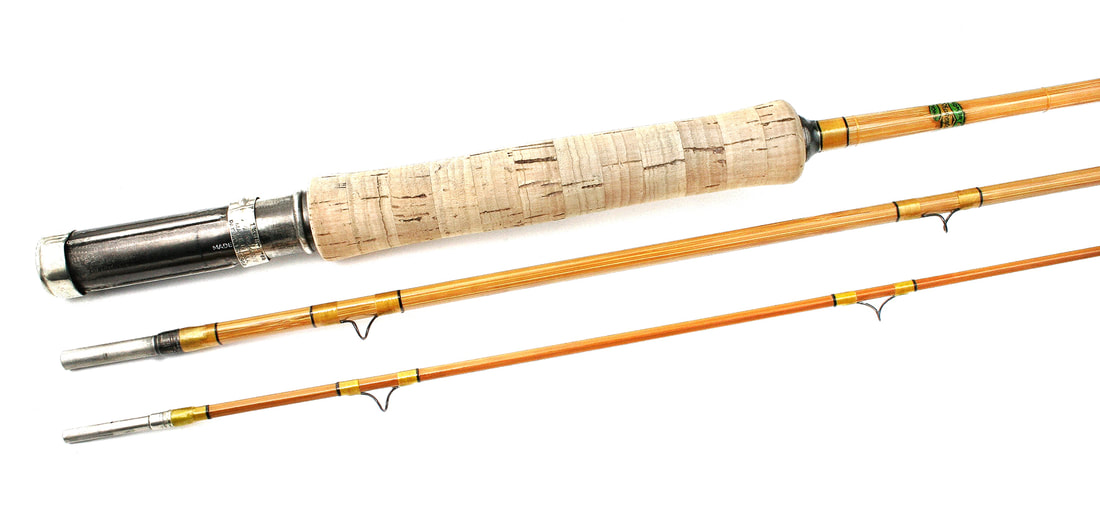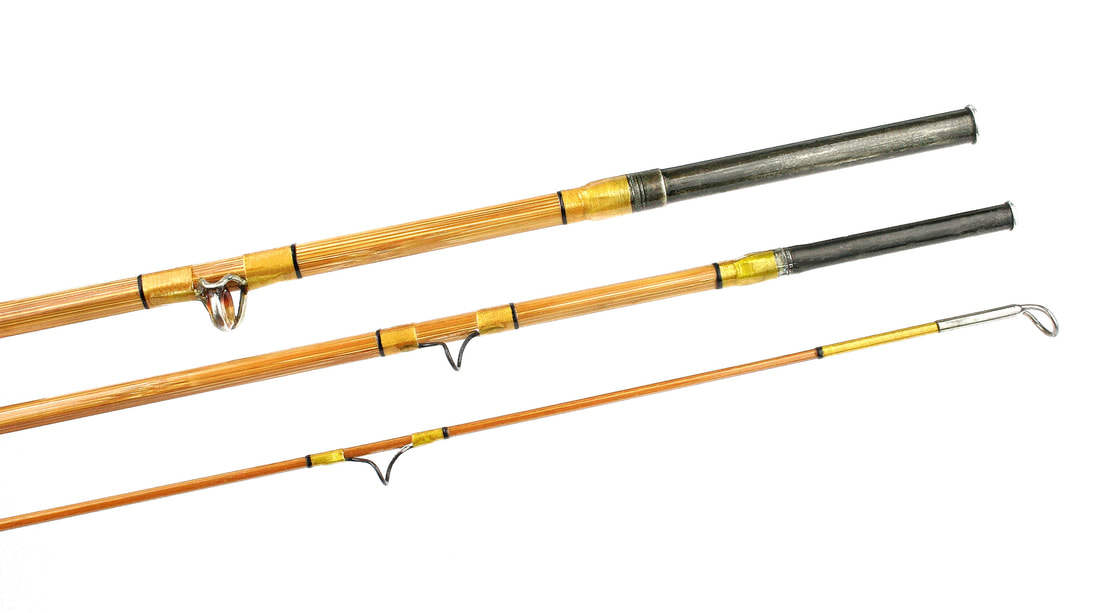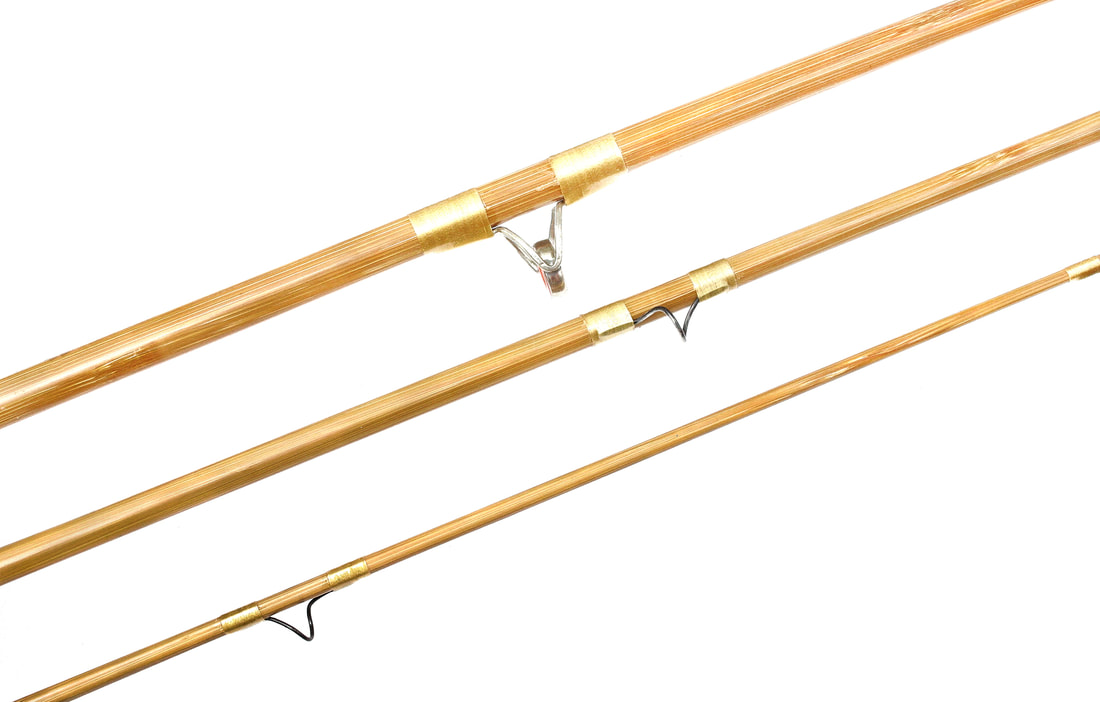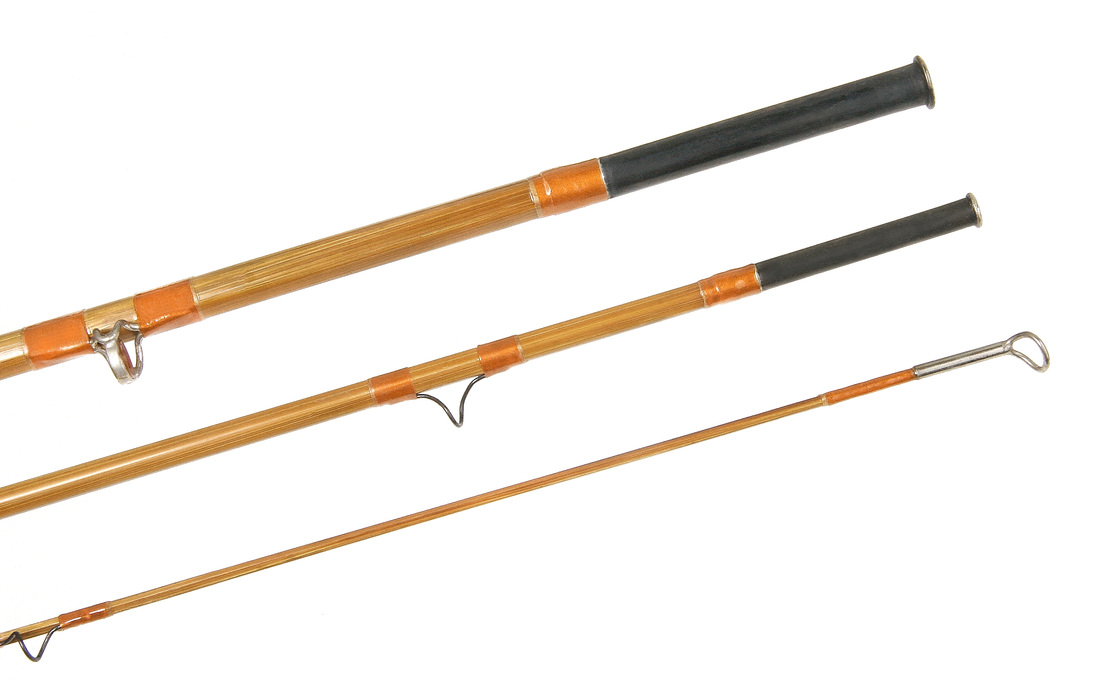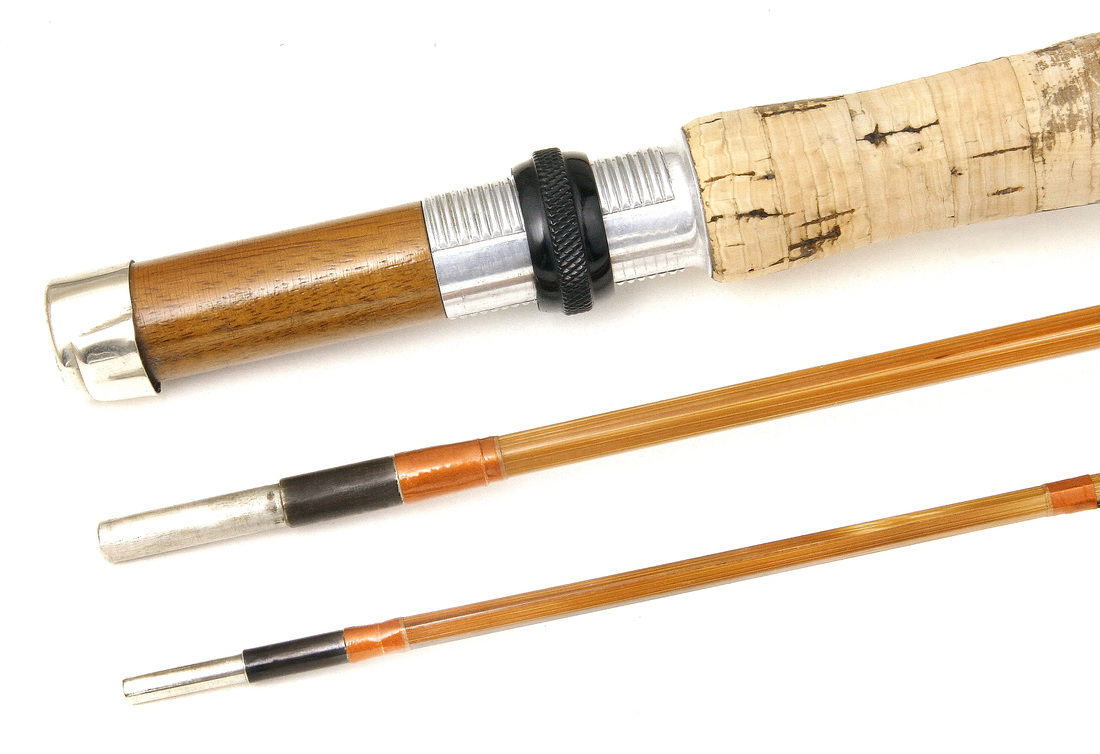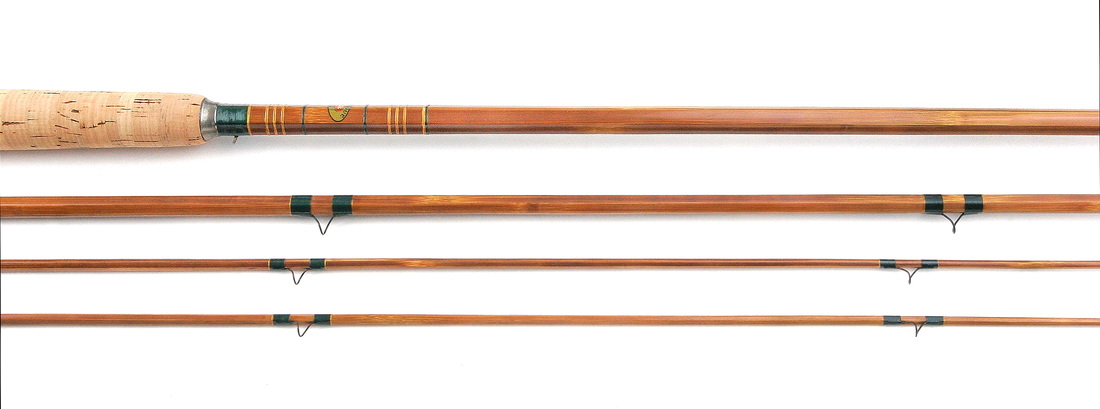Recent Restorations
|
"Your restoration of my father's split bamboo rods was truly remarkable." D. Panchot, Hartstene Island, WA |
1920's Edwards fly rods, 8-1/2, 8-1/2, 8 ft (completed 3-25)
Of three vintage EW Edwards fly rods received from Virginia owner, Abbie & Imbrie rod appeared to be in original condition, while the other two EW Edwards De Luxe rods had received previous repair & refinishing. All three rods required repair, cleaning, & varnish work.
Prominent among the maladies of Abbie & Imbrie rod was a broken male mid ferrule & broken mid section cane. Male ferrule remains were stubbornly wedged inside butt section female (not pictured).
Stuck ferrule piece was removed & vintage replacement male ferrule located. A scarf joint was then created at end of mid section to bring mid back to full length; scarf would be completely covered by ferrule, adding strength to the shorter-than-normal scarf joint (see photo above).
Stuck ferrule piece was removed & vintage replacement male ferrule located. A scarf joint was then created at end of mid section to bring mid back to full length; scarf would be completely covered by ferrule, adding strength to the shorter-than-normal scarf joint (see photo above).
|
Both EW Edwards 8-1/2 ft & 8 ft De Luxe models had been previously refinished & re-wrapped (excellent work, but w/ non-original hookkeeper & signature wrap pattern).
The 8-1/2 ft rod had only one tip section, 4 inches short. Since apparent break was at ferrule end, scarf joint was used to extend tip back to full length, & ferrule remounted. |
more restoration details, photos, & test casting to come...
1930's - 1940's L.L. Schauer fly rod, 8 ft (completed 3-25)
L.L. Schauer operated a small rod shop in Stroudsburg, PA from the 1930's to 1950's, just 1/2 mile from Broadhead Creek. He became regionally well known, & is said to have provided rods to two presidents - Teddy Roosevelt & Harry Truman. His rods were judged to be extremely well crafted.
|
Rod inscription says '8 FT Fly' (and owner's name), but what appears as original rod tube is marked '#31. Schauer 8', 3/2, LTMF, Custom Trout 275'.
With 11 & 16 ferrules, & tips 0.70" (uv), test casting showed the rod to be light & responsive w/ DT5F line (406 brand, true to weight). Casts were made from 15 to 50 ft, w/ delicacy in close to substantial power on longer casts. more photos & text to come...
|
1930's EW Edwards Sons Mt.Carmel fly rod, 9 ft (completed 3-23)
Having several examples of the rod model in restoration is a wonderful situation. Comparing these examples helps distinguish original wraps from re-wraps, establishes correct original guide type & spacing, & informs selection of color preserver & varnish. All three Mt.Carmel's are from the same period at Horton (1931-1937), when Gene & Bill Edwards continued to craft beautifully built Edwards rods.
This venerable Edwards fly rod had seen much use over its long lifetime, followed by poor storage. Its one surviving tip section was broken 1 ft from tip, & the remaining cane was partially delaminated due to moisture. Also the cane was badly 'water spotted' throughout its length. Cork was badly worn, while guides, ferrules & reel seat were badly corroded.
...more photos & text to come
|
|
|
1900 - 1915 Antique Mortised Butt fly rod, 10 ft (Completed 10-21)
Many early mortised butt rods appear in their velvet covered slotted rod forms, w/o engraved name or other maker ID. They appear as works of art in this age of mass produced & marketed rods, even among the many fine bamboo rods crafted by current day makers. One has only to deconstruct the handle /mortised butt area to see the planning & careful piecing required to create such masterpieces.
At the turn of the century & years following, many rod makers sourced their components wherever they were available, & Thomas Chubb Rod Co. was a big player in providing quality components to the trade. Even after Montague purchased the Chubb company, well know makers (including EW Edwards) used their ferrules w/ or w/o modification for their own rods. The components on this mortised butt rod, all high quality, appear to have come from Chubb/ Montague.
At the turn of the century & years following, many rod makers sourced their components wherever they were available, & Thomas Chubb Rod Co. was a big player in providing quality components to the trade. Even after Montague purchased the Chubb company, well know makers (including EW Edwards) used their ferrules w/ or w/o modification for their own rods. The components on this mortised butt rod, all high quality, appear to have come from Chubb/ Montague.
|
|
Sent by its Maryland owner who fishes all his rods, this fine example of turn-of-the-century craftsmanship was in very good original condition, save short tip & missing 2nd tip. Although the grip was well worn, & varnish beginning to break down, many of the original silk wraps were still intact, including full intermediates.
Mild restoration required protecting many still solid original wraps, while removing degraded varnish. Over 2/3 of original silk wraps were preserved intact, while the remainder were rewrapped to match the originals. Original guides, cleaned & polished, were used where possible. Metal components were cleaned & polished, & loose ferrules corrected. 'Sets' were removed from tip & mid section. All original wraps were sealed & coated with thinned varnish, & full rod received new varnish (2 coats for butt section & mid; 1 coat for the tip section). Owner's preference to preserve evidence of use was honored, so cork grip was left 'as found'. [*See 'Test Casting' page for additional photos & casting information.] |
1940 - 1950's Payne & Leonard fly rods, 8 ft, 8-1/2ft , 3/2, 3/2/2 (Completed 9-21)
|
When grandfather Dr Mike Spottswood left the Navy at the end of WWII, he settled in California's Bay Area where he practiced medicine, & later bought a cabin on the Fall river in the ranch country of northern CA.
In the early 1950's he acquired two fine fly rods, an 8' Payne & an 8-1/2' Leonard, which were first taken on a guided horse packing trip into the High Sierra's. His daughter Barbara, 10 at the time, remembers fishing being a main activity during that trip. Taking good care of his rods, when a fracture occurred in the mid section of the Leonard, Mike ordered a replacement section from Leonard in NY. In those days this was common practice. Replacement sections were usually well matched to the original rods, & cost not much more than a song by today's standards! Grandson Mike acquired a number of his grandfather's rods including the Payne & Leonard, which by this time needed a few guide wraps replaced as well as re-coating of original wraps. In addition the original Leonard mid section, which had been subject to what may have been a field repair, needed cleanup & a proper 'invisible wrap' added to the fractured area. Original varnish needed polishing, as well as touch-up /recoating w/ new spar varnish. Nickel silver components were cleaned & polished, oxidized Payne ferrules re-blued, & reel seat barrels refinished. These two fine bamboo fly rods, well used, but now in close to original condition, remain a family legacy. |
|
|
1930 -1931 Montague 'Flipline' fly rod, 8-1/2 ft (Completed 6-21)
|
This early Montague rod caught my eye on the big auction site, having high quality ferrules, & a beautiful 'butterfly' slide band nickel silver reel seat. Many early Montague rods have slow 'wet fly' actions, but something about this rod led me to believe it might be different...
When the rod arrived, I quickly gave it a 'waggle', & was pleased to find a moderate dry fly action, akin to some early Edwards rods. Despite assurances the cane was sound, I discovered several partial de-laminations, as well as a split in the single tip section. After re-gluing the split, an invisible wrap was added to further strengthen the area. Incipient de-lamination appeared to be only surface deep, so waterproof glue was applied to the surface openings to prevent further moisture entry. Heavy stains from wetted guide feet were partly removed w/ Oxalic acid, & the rod was completely re-wrapped following the pattern of original silks. ...more text to come |
1885 - 1895 Leonard 'Mills Standard' fly rod, 9-1/2 ft , Calcutta (Completed 10-20)
|
This historic rod, w/ distinctive swelled butt & rattan grip, was produced by H.L. Leonard for William Mills & Son circa 1885 -1895. It was owned by Mr. William Malcolm Foord, an avid & lifelong fly fisherman, & the grandfather of the wife of present owner. Mr. Foord was a member of the Marshepaug Forest Club, founded in 1913 on the East Branch of the Shepaug River in Litchfield, CT. He served as Treasurer of the club in 1920. He is known to have fished this rod for many years on the club’s private waters.
Fine nickel silver components, loose ring guides & tip top were all present, under original silk wraps & aged varnish. Ferrule re-setting & replacement occurred at a previous time, to address breakage or shortening of rod sections. Original rattan grip in good condition shows evidence of careful use by Mr. Foord over many years. |
|
In restoration, original wraps on tip section were preserved, while new matching silk was added to the butt & mid sections, following original wrap pattern. Ferrule fit was re-adjusted to allow for secure assembly, & if desired, use on the water.
|
 "Capt. Wm. M. Foord's Gorge"
"Capt. Wm. M. Foord's Gorge"
For his granddaughter, Katherine Malcolm Foord Arthur, & her husband, Lindsay Arthur, Mr Foord's rod is a cherished keepsake, recalling both the legacy of her grandfather, as well as the original meeting & proposal of her parents-to-be at the club cabin on the Shepaug. In a secluded glen in the forest, there remains a plaque on a small bridge over the river in memory of Mr. Foord.
1910 - 1919 Dame Stoddard 'HUB Special' fly rod, 8-1/2 ft (Completed 8-20)
This 100+ year old Dame Stoddard 'HUB Special' (Boston) was put up in a form case, & perhaps due to this, has remained very straight w/ all sections full length, including two very fine tips (0.70 in). Hatton [Rod Crafting, 2005] identifies these 1900-1920 Dame Stoddard models [eg "Neverbreak"] as likely made by FE Thomas, or very early Varney-Montague, owing to the high quality of cane work (flat-to-flat dimensions vary < .004 in). Also the high quality Chubb / Montague nickel silver components found on this rod were used by many makers in these early years, including FE Thomas & EW Edwards.
|
Test casting this delicate 8-1/2 ft rod* was a long awaited pleasure. Starting w/ a Sci Anglers 4DTF on a breezy summer evening, I was puzzled by the seeming imbalance of the rod / line combination. With its fine tip & mid sections, I had judged the rod suitable for a 4 wt line, but the all-over-the-place casting results were puzzling at best.
Next day I regrouped w/ a 5 wt (true) 5DTF '406', & smiled when the rod came alive in my hands. (to be continued) |
***UPDATE, 8-20-21: Rod performed well on small local river w/DT5F; casts of 10 - 40 ft; full action w/some backbone. Rod threw very open loops, hooking many branches in tight quarters along heavily tree-lined river (no fault of the rod!). Roll casts were excellent. Small ring style tip tops were often fouled w/ fly line. MF
* NOTE: My preferences run with Tom McGuane: "I like rods of all lengths, as long as they are 8-1/2 ft!" MF
1931 - 1933 Shakespeare 1338-B Fly Rod, 8-1/2 ft (Completed 9-18)
The long accepted wisdom about Shakespeare bamboo rods is that Shakespeare never made their own rods. It was believed Shakespeare contracted with Montague, South Bend & Heddon to provide their models, with the top models made by Gene Edwards starting in 1937. Shakespeare fly rods were appointed with components just different enough from the maker's own models to make them seem distinct [Sinclair,1994].
This high quality Shakespeare rod was found re-wrapped in nylon w/ little regard for original colors; the bamboo was coated with polyurethane. The distinctive "torpedo" shaped grip was badly deteriorated & the one remaining tip was 6 in short. The rod was completely stripped of the nylon wraps & poly, and a new full wells cork grip built from flor grade cork. Period correct small agate stripper, hardened steel snakes & tip top were added w/ fine silk in proper original colors. The short tip was replaced with a full length tip having a matching taper from old Gene Edwards rod shop stock, & the ferrules & winding check re-blued.
It is a light & fine casting rod, taking a #5 wt, line, & it provided several evenings of late season fun on my local river with a newly refurbished silk line.
It is a light & fine casting rod, taking a #5 wt, line, & it provided several evenings of late season fun on my local river with a newly refurbished silk line.
1920-30's Leonard Tournament Fly Rod, 9 ft (Completed 7-17)
Restoration of this powerful lightweight 1920's Leonard Tournament was completed by Bamboo Rod Works following incomplete work by another shop. A treasured gift from his favorite high school shop teacher & mentor, the rod belonged to the teacher's grandfather & held a special place in its owner's memory.
Original wraps were matched with vintage pale yellow silk combined with dark red Pearsalls Gossamer silk, coated with shellac to match the original treatment. The week following its restoration, the rod was paired with a vintage Hardy reel, and used on a long-awaited float trip on Idaho's Teton River.
Original wraps were matched with vintage pale yellow silk combined with dark red Pearsalls Gossamer silk, coated with shellac to match the original treatment. The week following its restoration, the rod was paired with a vintage Hardy reel, and used on a long-awaited float trip on Idaho's Teton River.
"Thank you, Mark, for your commitment & quality workmanship in restoring this very special H.L. Leonard rod. It is a splendid & beautiful work of art I will fish & display for many years to come."
S. Yoshino, Snoqualmie, WA

Folsom Arms #1520 (Edwards), 8-1/2 ft (Completed 5-16)
This high quality Edwards trade rod was made for Folsom Arms sometime between 1919 and 1924 while Edwards supervised rod production at Winchester, or afterwards from 1924 to 1929 when Edwards again set up his own rod shop with his sons. It exhibits the characteristic Edwards reel seat, the hard rubber winding check, & high quality oxidized hand-welted nickel silver ferrules. The wraps are orange & pongee, over lightly flamed cane, with the usual Edwards winding pattern at the hook keeper.
....This lovely delicate 8-1/2 footer casts beautifully with a DT5 line.
This high quality Edwards trade rod was made for Folsom Arms sometime between 1919 and 1924 while Edwards supervised rod production at Winchester, or afterwards from 1924 to 1929 when Edwards again set up his own rod shop with his sons. It exhibits the characteristic Edwards reel seat, the hard rubber winding check, & high quality oxidized hand-welted nickel silver ferrules. The wraps are orange & pongee, over lightly flamed cane, with the usual Edwards winding pattern at the hook keeper.
....This lovely delicate 8-1/2 footer casts beautifully with a DT5 line.

1927 Heddon #14 Fly Rod, 9 ft (Completed 6-15)
This rod was found among a bundle of bamboo sticks in the corner of a local reel repair shop. All the bamboo was dirty, stained, & splattered w/ white paint. The narrow cork rings on the butt section caught my eye, & I realized it was a very early Heddon fly rod from 1927. The mid & tip sections were there, but wraps & guides were missing, ferrules loose, w/ one stuck & another bent. The rod was 'all there', however!
Bringing this historic rod back to its former bright & fishable condition was a pleasure....
This rod was found among a bundle of bamboo sticks in the corner of a local reel repair shop. All the bamboo was dirty, stained, & splattered w/ white paint. The narrow cork rings on the butt section caught my eye, & I realized it was a very early Heddon fly rod from 1927. The mid & tip sections were there, but wraps & guides were missing, ferrules loose, w/ one stuck & another bent. The rod was 'all there', however!
Bringing this historic rod back to its former bright & fishable condition was a pleasure....

1930's Montague Trail Salmon Fly Rod, 12 ft. (Completed 3-16)
Blued hand-welted serrated nickel silver ferrules, blued nickel silver screw lock reel seat & winding check. Elongated cigar cork grip w/ fighting butt. Blackened steel snake guides + Agate stripping guide & tip top. Bamboo & ferrules in solid condition.
Damaged wraps, corroded snake guides, corroded tip tops, damaged stripper & melted varnish required complete restoration.
